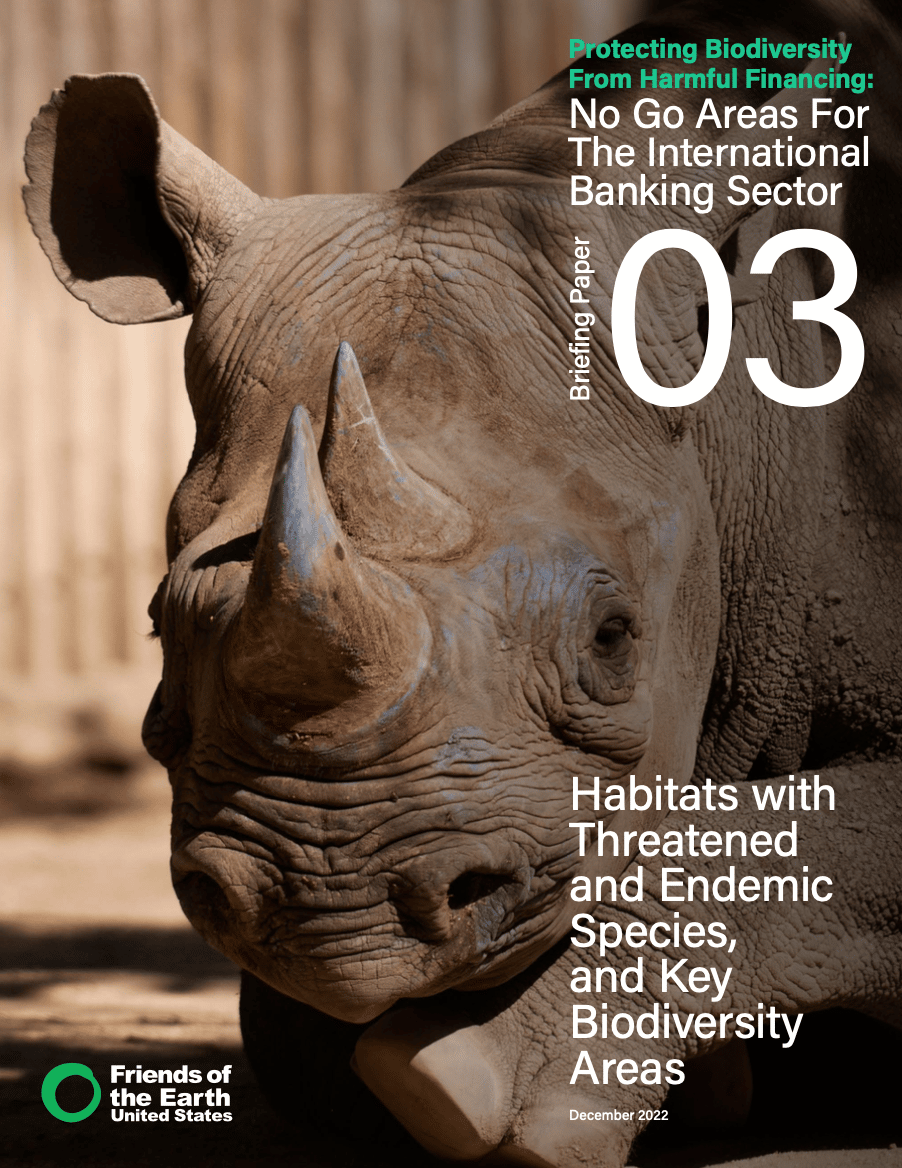Protecting Biodiversity from Harmful Financing: Habitats with Threatened and Endemic Species, and Key Biodiversity Areas

Friends of the Earth US’ new briefing, “Protecting biodiversity from harmful financing: Habitats with Threatened and Endemic Species, and Key Biodiversity Areas,” calls on banks and financiers to prohibit direct and indirect financing to activities and projects which may harm these critical areas. Within the next few decades, one million species are estimated to be at risk of extinction. Biodiversity protection is not only important in its own right, but also is critical for contributing to and maintaining important ecosystem functions and processes which support all life on Earth. In protecting Key Biodiversity Areas and habitats with threatened and endangered species, this paper provides key lessons in illustrating how banks and financiers can improve their policies and practices so that biodiversity risks are fully and accurately accounted for in their financing.
This paper is part of Friends of the Earth US’ new Protecting Biodiversity from Harmful Financing briefing paper series, which underscores why banks and financiers should exclude harmful, unsustainable financing to activities and projects which impact critical, at-risk ecosystems. Each briefing paper is dedicated to a key area as identified by the Banks and Biodiversity Initiative’s eight proposed No Go Areas. Key Biodiversity Areas and habitats with threatened and endemic species are considered as No Go Area 3, which is Paper 03 of the series. Briefing papers focusing on No Go Areas 4-8 are forthcoming.
Key Takeaways
- Banks and financiers should establish an institutional objective to actively halt and reverse biodiversity loss, while simultaneously aspiring to restore ecosystem functions.
- Biodiversity is a critical contributor and indicator of the health of ecosystem functions.
- Banks and financiers are exposed to material risks of biodiversity loss in two ways – firstly, in terms of directly driving or exacerbating negative biodiversity impacts caused by specific financed activities; and secondly, in terms of how such financed activities may in turn contribute to and drive the broader, systemic biodiversity loss (such as land use change, pollution, climate change, and over-exploitation of natural resources), which in turn impacts the long-term sustainability of sectors or areas where a financier may invest in.
- An effective, immediate approach to minimizing a bank’s impact on biodiversity loss is to prohibit financing in areas with Near Threatened, Vulnerable, Endangered, Critically Endangered, and endemic species, in addition to Key Biodiversity Areas.
- Bank and financier definitions of Critical Habitat should include habitats of Near Threatened, Vulnerable, Endangered, Critically Endangered, and endemic species, in addition to KBA
- Offsets as a mitigation measure are ineffective in managing biodiversity risks.
- The use of biodiversity tools and datasets are an important starting point when undertaking environmental and biodiversity assessments, but their use should not be seen as a proxy or an end point in due diligence processes.
- Depending if most or all of a non-threatened species’ population occurs at a particular site (especially for range restricted species), a species could become highly threatened by a bank’s decision to finance activities in an area.
- It is important for banks to not only consider species which are currently threatened, but to also consider how proposed bank financed activities can tip the scale in potentially causing species to become threatened.
- Vested or conflicts of interests commonly result in inadequate or invalid EIA documents.
- Banks and financiers should establish specialized staff or processes to interrogate and validate Environmental Impact Assessment (EIA) findings, and disclose EIAs and relevant documents publicly in order to encourage independent verification of such assessments.
Friends of the Earth US is part of the Banks and Biodiversity Initiative, a civil society coalition which advocates that banks and financiers strengthen their biodiversity policies and practices in order to halt and reverse biodiversity loss. Learn more at Banksandbiodiversity.org.
Ways to Support Our Work

Read Latest News
Stay informed and inspired. Read our latest press releases to see how we’re making a difference for the planet.

See Our Impact
See the real wins your support made possible. Read about the campaign wins we’ve fought for and won together.

Donate Today
Help power change. It takes support from environmental champions like you to build a more healthy and just world.